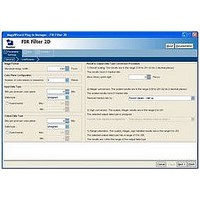IPSR-VIDEO Altera, IPSR-VIDEO Datasheet - Page 121

IPSR-VIDEO
Manufacturer Part Number
IPSR-VIDEO
Description
RENEWAL Of IPS-VIDEO
Manufacturer
Altera
Series
IP Suitesr
Datasheet
1.IPS-VIDEO.pdf
(202 pages)
Specifications of IPSR-VIDEO
Software Application
IP CORE, SUITES
Supported Families
Arria GX, Cyclone II, HardCopy II, Stratix II
Features
Common Avalon Streaming (Avalon-St) Interface And Avalon-St Video Protocol
Core Architecture
FPGA
Core Sub-architecture
Arria, Cyclone, Stratix
Rohs Compliant
NA
Lead Free Status / RoHS Status
na
- Current page: 121 of 202
- Download datasheet (6Mb)
Chapter 5: Functional Descriptions
Deinterlacer
January 2011 Altera Corporation
1
Output frames are produced by filling in the missing lines from the current field with
the linear interpolation of the lines above and below them. At the top of an F1 field or
the bottom of an F0 field there is only one line available so it is just duplicated. The
function only uses the current field, therefore if the output frame rate is the same as
the input frame rate, the function discards half of the input fields.
Weave
Weave deinterlacing creates an output frame by filling all of the missing lines in the
current field with lines from the previous field. This option gives good results for still
parts of an image but unpleasant artefacts in moving parts.
The weave algorithm requires external memory, so either double or triple-buffering
must be selected. This makes it significantly more expensive in logic elements and
external RAM bandwidth than either of the bob algorithms, if external buffering is not
otherwise required.
The results of the weave algorithm can sometimes be perfect, in the instance where
pairs of interlaced fields have been created from original progressive frames. Weave
simply stitches the frames back together and the results are the same as the original,
as long as output frame rate equal to input frame rate is selected and the correct pairs
of fields are put together. Usually progressive sources split each frame into a pair
consisting of an F0 field followed by an F1 field, so selecting F1 to be the current field
often yields the best results.
Motion-Adaptive
The Deinterlacer MegaCore function provides a simple motion-adaptive algorithm.
This is the most sophisticated of the algorithms provided but also the most expensive,
both in terms of logic area and external memory bandwidth requirement.
This algorithm avoids the weaknesses of bob and weave algorithms by using a form
of bob deinterlacing for moving areas of the image and weave style deinterlacing for
still areas.
If the input is 4:2:2 Y’CbCr subsampled data, the compatibility mode for 4:2:2 data
should be enabled to prevent the motion adaptive algorithm from introducing
chroma artefacts when using bob deinterlacing for moving regions.
Use the Motion bleed algorithm to prevent the motion value from falling too fast at a
specific pixel position. If the motion computed from the current and the previous
pixels is higher than the stored motion value, the stored motion value is irrelevant and
the function uses the computed motion in the blending algorithm, which becomes the
next stored motion value. However, if the computed motion value is lower than the
stored motion value, the following actions occur:
■
■
This computed motion means that the motion that the blending algorithm uses climbs
up immediately, but takes about four or five frames to stabilize.
The blending algorithm uses the stored motion value
The next stored motion value is an average of the computed motion and of the
stored motion
Video and Image Processing Suite User Guide
5–41
Related parts for IPSR-VIDEO
Image
Part Number
Description
Manufacturer
Datasheet
Request
R

Part Number:
Description:
CYCLONE II STARTER KIT EP2C20N
Manufacturer:
Altera
Datasheet:

Part Number:
Description:
CPLD, EP610 Family, ECMOS Process, 300 Gates, 16 Macro Cells, 16 Reg., 16 User I/Os, 5V Supply, 35 Speed Grade, 24DIP
Manufacturer:
Altera Corporation
Datasheet:

Part Number:
Description:
CPLD, EP610 Family, ECMOS Process, 300 Gates, 16 Macro Cells, 16 Reg., 16 User I/Os, 5V Supply, 15 Speed Grade, 24DIP
Manufacturer:
Altera Corporation
Datasheet:

Part Number:
Description:
Manufacturer:
Altera Corporation
Datasheet:

Part Number:
Description:
CPLD, EP610 Family, ECMOS Process, 300 Gates, 16 Macro Cells, 16 Reg., 16 User I/Os, 5V Supply, 30 Speed Grade, 24DIP
Manufacturer:
Altera Corporation
Datasheet:

Part Number:
Description:
High-performance, low-power erasable programmable logic devices with 8 macrocells, 10ns
Manufacturer:
Altera Corporation
Datasheet:

Part Number:
Description:
High-performance, low-power erasable programmable logic devices with 8 macrocells, 7ns
Manufacturer:
Altera Corporation
Datasheet:

Part Number:
Description:
Classic EPLD
Manufacturer:
Altera Corporation
Datasheet:

Part Number:
Description:
High-performance, low-power erasable programmable logic devices with 8 macrocells, 10ns
Manufacturer:
Altera Corporation
Datasheet:

Part Number:
Description:
Manufacturer:
Altera Corporation
Datasheet:

Part Number:
Description:
Manufacturer:
Altera Corporation
Datasheet:











